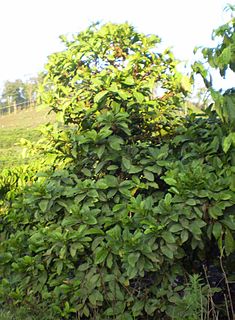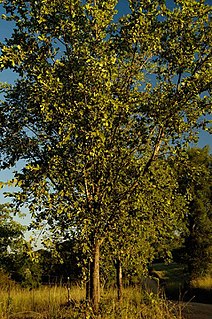
The Rubiaceae are a family of flowering plants, commonly known as the coffee, madder, or bedstraw family. It consists of terrestrial trees, shrubs, lianas, or herbs that are recognizable by simple, opposite leaves with interpetiolar stipules and sympetalous actinomorphic flowers. The family contains about 13,500 species in about 620 genera, which makes it the fourth-largest angiosperm family. Rubiaceae has a cosmopolitan distribution; however, the largest species diversity is concentrated in the tropics and subtropics. Economically important species include Coffea, the source of coffee, Cinchona, the source of the antimalarial alkaloid quinine, some dye plants, and ornamental cultivars.

Galium is a large genus of annual and perennial herbaceous plants in the family Rubiaceae, occurring in the temperate zones of both the Northern and Southern Hemispheres. Some species are informally known as bedstraw.

Psychotria is a genus of flowering plants in the family Rubiaceae. It contains 1,582 species and is therefore one of the largest genera of flowering plants. The genus has a pantropical distribution and members of the genus are small understorey trees in tropical forests. Some species are endangered or facing extinction due to deforestation, especially species of central Africa and the Pacific.
Blepharidium is a monotypic genus of flowering plants in the family Rubiaceae. The genus contains only one species, viz. Blepharidium guatemalense, which is native to Guatemala, Honduras and southern Mexico. Older works might mention two species.

Guettarda is a plant genus in the family Rubiaceae. Most of these plants are known by the common name Velvetseed. Estimates of the number of species range from about 50 to 162. Most of the species are neotropical. Twenty are found in New Caledonia and one reaches Australia. A few others are found on islands and in coastal areas of the Indian and Pacific Oceans.
Robynsia is a monotypic genus of flowering plants in the family Rubiaceae. It was described by John Hutchinson and was named after his friend and colleague Walter Robyns. The genus contains only one species, Robynsia glabrata, which is found in Ghana, Ivory Coast and Nigeria. The species is morphologically similar to the genus Cuviera but differs by having long, slender corolla tubes.

Coffea liberica is a species of flowering plant in the family Rubiaceae from which coffee is produced. It is native to western and central Africa from Liberia to Uganda and Angola, and has become naturalized in the Philippines, Indonesia, Seychelles, the Andaman & Nicobar Islands, Malaysia

Burchellia is a monotypic genus of flowering plants in the family Rubiaceae. The genus contains only one species, viz. Burchellia bubalina, which is endemic to southern Africa: the Cape Provinces, KwaZulu-Natal and the Northern Provinces in South Africa, and Eswatini. It is commonly known as "wild pomegranate" (English) or "wildegranaat" (Afrikaans).

Augusta is a genus of flowering plants in the family Rubiaceae. It is found in tropical Latin America from Mexico to Brazil and also in the southwestern Pacific.
Retiniphyllum is a genus of flowering plants in the family Rubiaceae and contains 20 species. It is the only genus in the tribe Retiniphylleae. The representatives are shrubs or small trees that grow in white sand soils in tropical South America. They are mainly distributed in the Guayana Region (Venezuela) but also occur in the Amazon Basin, the eastern Andes and central and eastern Brasil.
Temnopteryx is a monotypic genus of flowering plants in the family Rubiaceae. It was originally described by Joseph Dalton Hooker in 1873. It is found in Cameroon, Equatorial Guinee and Gabon.
Colleteria is a genus of flowering plants in the family Rubiaceae. The genus is found in the Caribbean.
Coptosapelta is a genus of flowering plants in the family Rubiaceae. It is found in tropical and subtropical Asia. The genus has not been placed within a subfamily and is sister to the rest of Rubiaceae.

Crossopteryx is a monotypic genus of flowering plants in the family Rubiaceae. The genus contains only one species, viz. Crossopteryx febrifuga, which is found in tropical and southern Africa.
Deccania is a monotypic genus of flowering plants in the family Rubiaceae. The genus contains only one species, viz. Deccania pubescens, which is endemic to India.
Didymochlamys is a genus of flowering plants in the family Rubiaceae. The genus is found from Nicaragua to Guyana and Ecuador.
Dunnia is a monotypic genus of flowering plants in the family Rubiaceae. The genus contains only one species, viz. Dunnia sinensis, which is endemic to Guangdong.

Euclinia is a genus of flowering plants in the family Rubiaceae. The genus is found in tropical Africa and Madagascar.

Spermacoceae is a tribe of flowering plants in the family Rubiaceae and contains about 1346 species in 57 genera. Its representatives are found in the tropics and subtropics.
Trailliaedoxa is a monotypic genus of flowering plants in the family Rubiaceae. The genus contains only one species, viz. Trailliaedoxa gracilis, which is endemic to south-central China. It is also the only species in the tribe Trailliaedoxeae.









